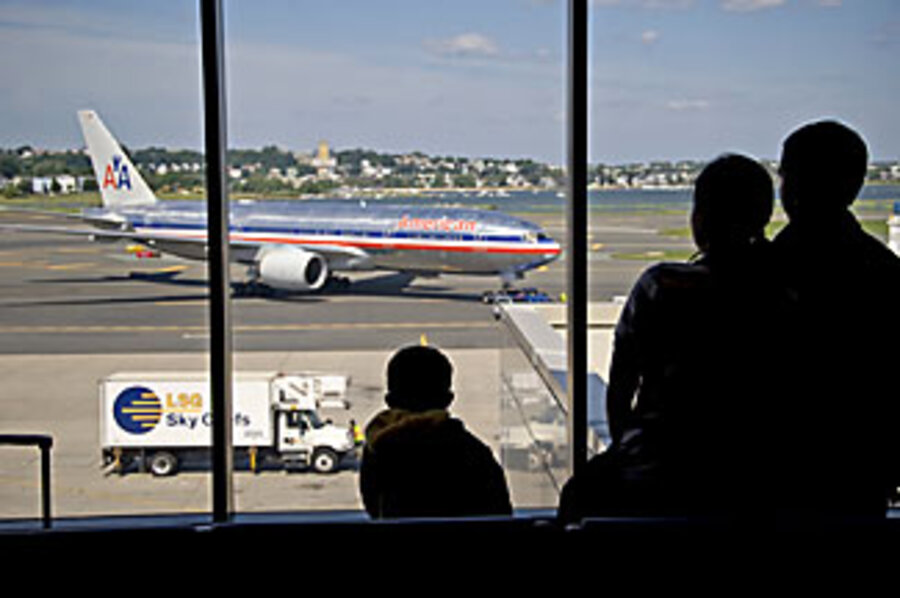Airline passengers revolt against hours spent on the tarmac
Loading...
| New York
If you're stranded on a plane for more than three hours, should the airline be required to make sure you have food, water, and clean bathrooms? Or should it take you back to the terminal?
That's the heart of a fierce debate going on in Washington, one that has very real consequences for hundreds of people every month who end up parked on the tarmac for more than three hours.
The Bureau of Transportation Statistics (BTS) reported this week that in January, almost 60 planes sat stranded on the tarmac for more than three hours. Another 39 diverted from their original destination were also delayed for three hours or more. Sixteen planes were delayed 10 hours or more because of being diverted.
Most passengers simply grumble at disrupted travel plans. But last week, a Scottish man was arrested after he tried to open the emergency door on a flight bound for Las Vegas that had sat on the tarmac for several hours.
That's an extreme example, but passengers' rights organizations say they receive thousands of complaints every month from frustrated people who feel trapped as they sit buckled into their seats for hours waiting for their plane to take off.
Several proposals for a passengers' bill of rights are pending in Congress. The Department of Transportation has also proposed regulations that would require all airlines to make contingency plans for lengthy tarmac delays and make them part of the legally binding "contract of carriage" that is part of every airline ticket.
The airlines are adamantly opposed to such measures. They say such contingency planning is better left to individual airlines, which could post them on their websites. Passengers' rights advocates contend that plans posted on websites would be unenforceable, and thus the airlines could ignore them.
For the airlines, the BTS figures on lengthy flight delays confirm what they've argued all along: that the number of flights involved in such delays is a small fraction of the more than 20,000 planes that take off every day and thus should not prompt new regulation.
"It comes as no surprise that with more detailed data, the number of reported delays is up slightly with the addition of roughly 26 delays per month," says David Castelveter, spokesman for the Air Transport Association (ATA), which represents the nation's major carriers.
Passengers' rights groups disagree.
Kate Hanni, executive director of flyersrights.org, questions the validity of the BTS statistics, and not for the first time. Last October, when the BTS first released its statistics on "Taxi-Out and Other Tarmac Times," Ms. Hanni and her organization found discrepancies between what frustrated fliers had reported to them and the BTS data.
It turned out that the airlines had found a loophole. They were not reporting lengthy tarmac delays for planes that had returned to the gate. Instead, they "reset" the clock when they returned to the terminal. That meant passengers who sat on the tarmac for four hours and returned to the gate, only to leave again on the same plane, were reported to be on flights that had "on time" departures. Hanni bought that to the BTS's attention.
The agency withdrew the data and created new reporting requirements. The revised data released this week "resulted in reporting of 107 flights with tarmac times of three hours or more that would not have been reported prior to the new rule that went into effect in October," BTS's David Smallen said in an e-mailed statement.
But Hanni and her group are still not satisfied that the BTS report accurately reflects the number of tarmac-stranded flights, and her group is currently analyzing the new data. BTS says if the group can prove the airlines are not reporting accurately, the data will be reviewed again.
"BTS has not received any specific reports of any three-hour tarmac times on domestic flights operated by the 19 reporting carriers from October to January other than those released Monday," according to Mr. Smallen. "If we receive any specific instances of unreported three-hour tarmac times, we will review the airline's entire submission."
Hanni is going ahead with an analysis, but she says that even if the BTS numbers are accurate, the fact that almost 60 planes were stranded on the tarmac for more than three hours in January warrants new laws or regulations to ensure those passengers are properly cared for.
"That's horrifying enough," she says, "yet the airlines are arguing that it represents such a small percentage of the flights ... that it ought to be allowed."
The ATA says the real problem behind the delays and stranded planes is the nation's antiquated air-traffic control system. That's what it believes needs attention – not the creation of new federal rules to protect passengers' rights.
"While this number [of tarmac delays of more than three hours] is still remarkably low ... what it tells us is that we are on the right track in calling for the aggressive rollout of a modernized air-traffic management system that will help drive these delay numbers even lower," says Mr. Castelveter of the ATA.





